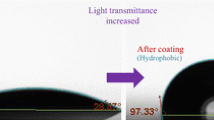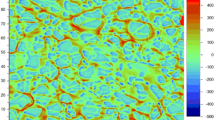Abstract
Organic translucent coatings with high glossiness and homogeneous colour distribution are highly sought due to their aesthetic properties. The application of such organic coatings on glass substrates such as mirrors and windows will not only to protect these surfaces from damage, but also as decorative purpose. Herein, the work described the preparation of translucent poly(methyl methacrylate), PMMA-based coatings on glass surfaces. Since PMMA has low adhesion ability onto glass, poly(methyl vinyl ether-alt-maleic acid monoethyl ester), PMVEMA-ES is proposed as an additive to promote the adhesion of PMMA onto glass surfaces. Various 4-hydroxycoumarinhydrazone derivatives (CADs) were used as dyes. The physical, optical, and thermal properties of the prepared coatings were investigated and correlated. The addition of PMVEMA-ES and CAD dyes altogether enhanced the adhesion of PMMA onto glass surfaces, as evidenced from cross-hatch adhesion tests, supported with TGA and DSC results. The presence of substituents has limited influence on the optical properties of coatings. The dyes have also contributed to the overall increased in coating glossiness, especially when alkyl groups were present in the dye. Moreover, the CAD dyes can be good candidates as colourants for translucent coating films as they have low coating opacity and high (> 90%) transmittance beyond 500 nm.












Similar content being viewed by others
References
Coan T, Barroso GS, Motz G, Bolzán A, Machado RAF (2013) Preparation of PMMA/hBN composite coatings for metal surface protection. Mater Res 16(6):1366–1372
Abidin Z, Nasir K, Jamari S, Saidon N, Lee S, Halim N, Yahya R (2013) The characteristics of a coating system containing lawsone dye colorant and PMMA-acrylic polyol blended resin. Pigm Resin Technol 42(2):128–136
Li R, Wu G, Hao Y, Peng J, Zhai M (2019) Radiation degradation or modification of poly (tetrafluoroethylene) and natural polymers. In: Ghozhong W; Maolin Z; Mozhen W (eds) Radiation technology for advanced materials. Elsevier, pp 141–182
Ali U, Karim KJBA, Buang NA (2015) A review of the properties and applications of poly (methyl methacrylate)(PMMA). Polym Rev 55(4):678–705
Wang TL, Hwang WS, Yeh MH (2007) Preparation, properties, and anticorrosion application of poly (methyl methacrylate)/montmorillonite nanocomposites coating on brass via solution polymerization. J Appl Polym Sci 104(6):4135–4143
Hu H, Nair P (1996) Electrical and optical properties of poly (methyl methacrylate) sheets coated with chemically deposited CuS thin films. Surf Coat Technol 81(2–3):183–189
Demir MM, Memesa M, Castignolles P, Wegner G (2006) PMMA/zinc oxide nanocomposites prepared by in-situ bulk polymerization. Macromol Rapid Commun 27(10):763–770
Rybalko VP, Nikityuk AI, Pisarenko EI, Dyachenko PB, Korchmarek AS, Kireev VV (2016) Controlling the adhesion properties of high-filled polymethyl methacrylate composites. Polym Sci - D 9(4):359–363
Alemdar N, Karagoz B, Erciyes AT, Bicak N (2007) A method for polymethymetacrylate coating via self-curable unsaturated polyester primer on metal and glass surfaces. Prog Org Coat 60(1):69–74
Manah N, Sulaiman L, Azman N, Abidin ZHZ, Tajuddin HA, Halim NA (2019) Colour analysis of organic synthetic dye coating paint films consisting 4-hydroxycoumarin derivatives after exposed to UV-A. Mater Res Express 6(7):076418
Nasir K, Halim N, Tajuddin H, Arof A, Abidin Z (2013) The effect of PMMA on physical properties of dammar for coating paint application. Pigm Resin Technol 42(2):137–145
Mira A, Mateo CR, Mallavia R, Falco A (2017) Poly (methyl vinyl ether-alt-maleic acid) and ethyl monoester as building polymers for drug-loadable electrospun nanofibers. Sci Rep 7(1):1–13
Martínez-Ortega L, Mira A, Fernandez-Carvajal A, Mateo CR, Mallavia R, Falco A (2019) Development of a new delivery system based on drug-loadable electrospun nanofibers for psoriasis treatment. Pharmaceutics 11(1):14
Metwally MA, Bondock S, El-Desouky E, Abdou MM (2012) Synthesis, structure elucidation and application of some new azo disperse dyes derived from 4-hydroxycoumarin for dyeing polyester fabrics. Am J Chem 2:347–354
Gaffer H, Salem M, Marzouk M (2016) Synthesis of 4-hydroxy coumarin dyes and their applications. Pigm Resin Technol 45(5):320–329
Giri S, Mishra AK (1984) Fungicidal and molluscicidal activity of some heteroaryl carbinols and ethylenes. J Agric Food Chem 32(4):762–765
Sahoo J, Mekap SK, Kumar PS (2015) Synthesis, spectral characterization of some new 3-heteroaryl azo 4-hydroxy coumarin derivatives and their antimicrobial evaluation. J Taibah Univ Sci 9(2):187–195
Makhlouf M, Zeyada H (2016) Synthesis, structural analysis, spectrophotometric measurements and semiconducting properties of 3-phenyl azo-4-hydroxycoumarin thin films. Synth Met 211:1–13
Yazdanbakhsh M, Ghanadzadeh A, Moradi E (2007) Synthesis of some new azo dyes derived from 4-hydroxy coumarin and spectrometric determination of their acidic dissociation constants. J Mol Liq 136(1–2):165–168
Shawali AS, Harb NM, Badahdah KO (1985) A study of tautomerism in diazonium coupling products of 4-hydroxycoumarin. J Heterocycl Chem 22(5):1397–1403
Thompson RL, Narrainen AP, Eggleston SM, Ansari IA, Hutchings LR, Clarke N (2007) Recoverable surface modification using dendritic fluorocarbon functionalized PMMA. J Appl Polym Sci 105(2):623–628
Yong MY, Ang DTC, Sarih NM (2019) Novel natural rubber-based epoxy coatings. Prog Org Coat 135:105–113
Gonnet J-F (1999) Colour effects of co-pigmentation of anthocyanins revisited—2. A colorimetric look at the solutions of cyanin co-pigmented byrutin using the CIELAB scale. Food Chem 66(3):387–394
Ahmadpoor P, Nateri AS, Motaghitalab V (2013) The optical properties of PVA/TiO2 composite nanofibers. J Appl Polym Sci 130(1):78–85
Gałka P, Kowalonek J, Kaczmarek H (2014) Thermogravimetric analysis of thermal stability of poly (methyl methacrylate) films modified with photoinitiators. J Therm Anal Calorim 115(2):1387–1394
Manring LE (1989) Thermal degradation of poly (methyl methacrylate). 2. Vinyl-terminated polymer. Macromolecules 22(6):2673–2677
Manring LE, Sogah DY, Cohen GM (1989) Thermal degradation of poly (methyl methacrylate). 3. Polymer with head-to-head linkages. Macromolecules 22(12):4652–4654
Manring LE (1991) Thermal degradation of poly (methyl methacrylate). 4. Random side-group scission. Macromolecules 24(11):3304–3309
O’Connell C, Dollimore D (1999) Determination of the melting point using derivative thermogravimetry. Instrum Sci Technol 27(1):13–21
Chung K, Wu C, Malawer E (1990) Glass transition temperatures of poly (methyl vinyl ether-co-maleic anhydride)(PMVEMA) and poly (methyl vinyl ether-co-maleic acid)(PMVEMAC) and the kinetics of dehydration of PMVEMAC by thermal analysis. J Appl Polym Sci 41(3–4):793–803
Kuo S-W, Wu Y-C, Wang C-F, Jeong K-U (2009) Preparing low-surface-energy polymer materials by minimizing intermolecular hydrogen-bonding interactions. J Phys Chem C 113(48):20666–20673
Hu W-H, Huang K-W, Kuo S-W (2012) Heteronucleobase-functionalized benzoxazine: synthesis, thermal properties, and self-assembled structure formed through multiple hydrogen bonding interactions. Polym Chem 3(6):1546–1554
Shekh MI, Patel DM, Patel NN, Patel US, Patel KP, Patel RM (2018) Methacrylate copolymers and their composites with nano-CdS: synthesis, characterization, thermal behavior, and antimicrobial properties. Int J Ind Chem 9(2):153–166
Jeong SP, Renna LA, Boyle CJ, Kwak HS, Harder E, Damm W, Venkataraman D (2017) High energy density in azobenzene-based materials for photo-thermal batteries via controlled polymer architecture and polymer-solvent interactions. Sci Rep 7(1):1–12
Singh L, Ludovice PJ, Henderson CL (2003) Characterization of property variation in ultra-thin polymer films from molecular simulation. In: Advances in resist technology and processing XX. International Society for Optics and Photonics, vol 5039, pp 1008–1018
Kwei T (1984) The effect of hydrogen bonding on the glass transition temperatures of polymer mixtures. J Polym Sci Polym Lett Ed 22(6):307–313
Yang C-F, Wang H-C, Su C-C (2017) Enhancing the compatibility of poly (1,4-butylene adipate) and phenoxy resin in blends. Materials 10(7):692
Mokrzycki W, Tatol M (2011) Colour difference ∆E—a survey. Mach Graph Vis 20(4):383–411
Xie T, Kao W, Sun L, Wang J, Dai G, Li Z (2020) Preparation and characterization of self-matting waterborne polymer—an overview. Prog Org Coat 142:105569
Järnström J, Ihalainen P, Backfolk K, Peltonen J (2008) Roughness of pigment coatings and its influence on gloss. Appl Surf Sci 254(18):5741–5749
Dashtizadeh A, Abdouss M, Mahdavi H, Khorassani M (2011) Acrylic coatings exhibiting improved hardness, solvent resistance and glossiness by using silica nano-composites. Appl Surf Sci 257(6):2118–2125
Yang H, He Y, Wu Z, Miao J, Yang F, Lu Z (2018) Fabrication of a superhydrophobic and high-glossy copper coating on aluminum substrates. Appl Surf Sci 433:1192–1196
Bierwagen GP, Tallman DE (2001) Choice and measurement of crucial aircraft coatings system properties. Prog Org Coat 41(4):201–216
Trezza T, Krochta J (2001) Specular reflection, gloss, roughness and surface heterogeneity of biopolymer coatings. J Appl Polym Sci 79(12):2221–2229
Lee L-H, Chen W-C (2001) High-refractive-index thin films prepared from trialkoxysilane-capped poly (methyl methacrylate)—titania materials. Chem Mater 13(3):1137–1142
Funding
The authors would like to express gratitude to the Ministry of Higher Education (MOHE) Malaysia for providing the Fundamental Research Grant Scheme FP031-2014B. The authors would also like to thank University of Malaya for providing the Faculty Research Grant (GPF048B-2018). We acknowledge the financial support from the Ministry of Education Malaysia and the SLAB fellowship scheme from the University of Malaya for funding the Ph. D. studies of Shameer Hisham.
Author information
Authors and Affiliations
Corresponding author
Ethics declarations
Conflict of interest
The authors declare that there is no conflict of interest.
Availability of data and materials
Data and materials are available upon request.
Additional information
Publisher's Note
Springer Nature remains neutral with regard to jurisdictional claims in published maps and institutional affiliations.
Supplementary Information
Below is the link to the electronic supplementary material.
Rights and permissions
About this article
Cite this article
Hisham, S., Salim, M.F.Z., Chaibi, F.Z. et al. Influence of PMVEMA-ES and 4-hydroxycoumarin hydrazone dyes on the physico-optical properties of PMMA coating films. Polym. Bull. 79, 8669–8693 (2022). https://doi.org/10.1007/s00289-021-03925-1
Received:
Revised:
Accepted:
Published:
Issue Date:
DOI: https://doi.org/10.1007/s00289-021-03925-1




